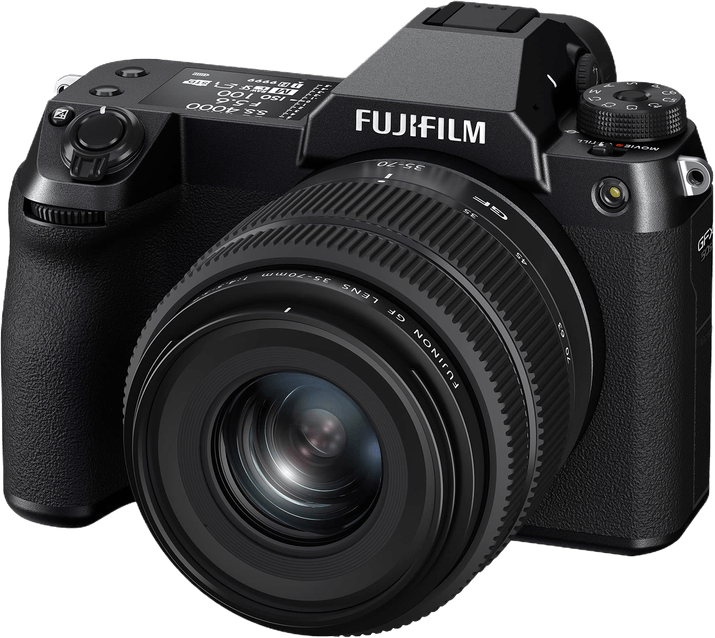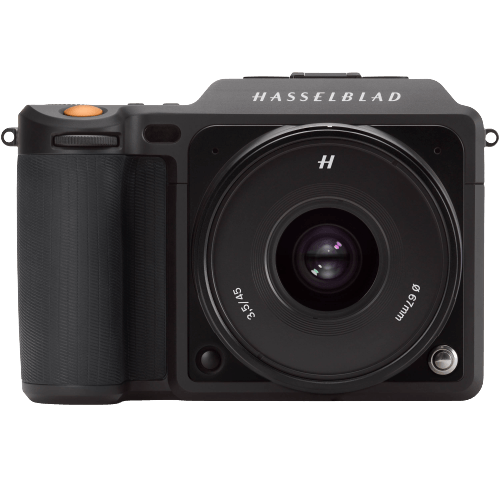Fujifilm GFX 50S II vs Hasselblad X1D 50c Comparison
Fujifilm GFX 50S II

Hasselblad X1D 50c

The Fujifilm GFX 50S II outperforms the Hasselblad X1D 50c, scoring 79/100 compared to 71/100. Both cameras share similarities, being mirrorless and boasting a 50-megapixel sensor. However, the GFX 50S II edges ahead with its 2021 release, offering more advanced features at a significantly lower launch price of $3,999, compared to the X1D 50c’s $8,995.
The Fujifilm camera also has a larger body, measuring 150 x 104 x 87mm and weighing 900g, providing better ergonomics. On the other hand, the Hasselblad X1D 50c is more compact (150 x 98 x 71mm) and lighter (725g), making it easier to carry.
Taking into account these factors, the Fujifilm GFX 50S II stands as the better option for its advanced features, better ergonomics, and more affordable price. However, the Hasselblad X1D 50c remains a solid choice for those prioritizing portability.
Fujifilm GFX 50S II vs Hasselblad X1D 50c Overview and Optics
The Fujifilm GFX 50S II edges out the Hasselblad X1D 50c in our optics comparison with a score of 77/100, compared to the Hasselblad’s 74/100. Both cameras share several specifications, such as having a CMOS sensor, medium format sensor size, and similar megapixel counts (51 for Fujifilm and 50 for Hasselblad). They also both utilize their respective proprietary lens mounts – Fujifilm G for the GFX 50S II and Hasselblad X for the X1D 50c.
The Fujifilm GFX 50S II outperforms the Hasselblad X1D 50c in a few key areas. First, it has a faster shooting speed of 3 frames per second, compared to the Hasselblad’s 2.3. This allows for quicker image capture, which can be crucial in certain situations. Additionally, the GFX 50S II features image stabilization, a significant advantage for photographers who require steadier shots or shoot in low-light conditions without a tripod.
Despite its lower score, the Hasselblad X1D 50c has its strengths. One notable advantage of the X1D 50c is its DXOMARK score of 102 for its sensor, a prestigious rating that attests to the camera’s image quality potential. Unfortunately, there is no comparable score for the Fujifilm GFX 50S II, as DXOMARK does not score Fujifilm cameras.
Taking these factors into consideration, the Fujifilm GFX 50S II is the winner in optics due to its faster shooting speed and image stabilization. However, the Hasselblad X1D 50c should not be overlooked, as its impressive DXOMARK score suggests it can deliver high-quality images. Ultimately, photographers should weigh these factors based on their specific needs and preferences when choosing between the two cameras.
Fujifilm GFX 50S II vs Hasselblad X1D 50c Video Performance
The Fujifilm GFX 50S II outperforms the Hasselblad X1D 50c in video capabilities with a score of 57/100 compared to the Hasselblad’s 43/100. Both cameras share some common video specifications, including Full HD video resolution and maximum video dimensions of 1920 x 1080. However, there are notable differences that make the Fujifilm GFX 50S II a superior choice for video recording.
The Fujifilm GFX 50S II offers a higher maximum video frame rate of 30fps, compared to the Hasselblad X1D 50c’s 25fps. This advantage allows the Fujifilm camera to capture smoother video footage, especially in fast-moving scenes. Furthermore, the Fujifilm GFX 50S II has built-in time-lapse functionality, which the Hasselblad X1D 50c lacks. This feature enables users to create stunning time-lapse videos without the need for additional software or equipment.
On the other hand, the Hasselblad X1D 50c does not offer any significant advantages in video capabilities over the Fujifilm GFX 50S II. The lower video frame rate and lack of time-lapse functionality limit its potential for capturing high-quality video content.
To conclude, the Fujifilm GFX 50S II is the clear winner in terms of video capabilities. With a higher video score, a faster maximum video frame rate, and built-in time-lapse functionality, it provides users with a more versatile and powerful tool for capturing video content. The Hasselblad X1D 50c, while sharing some common specifications with the Fujifilm GFX 50S II, falls short in delivering competitive video performance.
Fujifilm GFX 50S II vs Hasselblad X1D 50c Features and Benefits
The Fujifilm GFX 50S II outperforms the Hasselblad X1D 50c with a feature score of 87/100 compared to 68/100. Both cameras share some common specifications, such as touchscreen functionality, Wi-Fi connectivity, and 50-megapixel medium format sensors.
The Fujifilm GFX 50S II excels in several areas. It has a larger screen size of 3.2 inches compared to the Hasselblad’s 3 inches, providing a bigger and clearer view of captured images. Furthermore, it has a higher screen resolution of 2,360,000 dots, compared to the Hasselblad’s 920,000 dots, resulting in sharper image previews and better overall user experience. The Fujifilm GFX 50S II also features a flip screen, allowing for more flexible shooting angles and easier self-portraits. In addition, it supports Bluetooth connectivity, enabling seamless pairing with smartphones and other devices for remote control and image sharing.
On the other hand, the Hasselblad X1D 50c has its own advantages, such as built-in GPS functionality. This feature allows photographers to geotag their images, which can be useful for documenting travel and organizing photos based on location.
Taking these factors into account, the Fujifilm GFX 50S II clearly offers superior features, including a larger and higher-resolution screen, a flip screen, and Bluetooth connectivity. These enhancements contribute to its higher feature score and make it a more versatile camera overall. The Hasselblad X1D 50c, however, remains a strong contender with its GPS capability, appealing to photographers with specific geotagging needs.
Fujifilm GFX 50S II vs Hasselblad X1D 50c Storage and Battery
The Fujifilm GFX 50S II outperforms the Hasselblad X1D 50c in storage and battery with a score of 71/100, compared to the Hasselblad’s 49/100. Both cameras share common specifications, such as two memory card slots and compatibility with SD, SDHC, and SDXC cards. However, the Fujifilm GFX 50S II has an advantage with its UHS-II compatibility for faster data transfer.
The Fujifilm GFX 50S II also boasts a longer battery life, offering 440 shots per charge, while the Hasselblad X1D 50c achieves only 250 shots. Additionally, the Fujifilm GFX 50S II supports USB charging, making it more convenient for on-the-go photographers.
The Hasselblad X1D 50c does not have any significant advantages in storage and battery over the Fujifilm GFX 50S II. Considering these factors, the Fujifilm GFX 50S II is the superior choice for photographers seeking better storage and battery performance.
Fujifilm GFX 50S II vs Hasselblad X1D 50c – Our Verdict
Are you still undecided about which camera is right for you? Have a look at these popular comparisons that feature the Fujifilm GFX 50S II or the Hasselblad X1D 50c:

